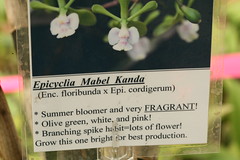An orchid name can be a mysterious thing if you don’t know how to read it. But fear not. It is actually quite straightforward. Let’s use the following orchid name as an example and break it into understandable pieces:
Phalaenopsis schilleriana ‘Pink Butterfly’, AM/AOS
Doesn’t it look like a foreign language? Well, it actually is. All scientific names are Latin. But don’t panic, you don’t need to learn Latin to understand orchid names.
Genus – The First Part of the Orchid Name
In this example, Phalaenopsis is the genus name. There are about 600 genera (plural of genus) in the orchid family. You may already be familiar with other genera – Cymbidium, Cattleya, Paphiopedilum, Vanda, Vanilla and Dendrobium are all different genera.
Many genera of orchids can be interbred to create new genera. For example, when Brassovola and Cattleya are interbred, the new genus name is Brassocattleya. Another example is Brassolaeliacattleya, which are made from interbreeding three genera – Brassovola, Laelia and Cattleya. Not too difficult, is it? You can easily tell which genera are used to make the new genus because usually their names are just chained together.
However, if there are more than three genera, the name would get ridiculously long, so the names are not just chained together when there are four or more genera. For example, Burrageara is an intergeneric hybrid made from Cochlioda, Miltonia, Odontoglossum and Oncidium. Usually when the genus name ends with “ara”, that means the genus is made up of four or more natural genera. But sometimes you will find that some names that end with ‘ara’ are only made up of three genera. Also, instead of being written as “Burrageara“, sometimes the genus name is written as “x Burrageara“. Having an x in the front of the genus name is actually the proper way to signify that it is an intergeneric genus.
Genus names are usually abbreviated. For example, the abbreviation of Phalaenopsis is Phal. and Cattleya is just C. You can find a list of genus name abbreviations from the Royal Horticulture Society.
Also, the genus name is supposed to be capitalized and italicized, but most of the times people don’t do it properly.
Species or “Grex” – The Second Part of Orchid Name
In this example, the second part of the orchid name – schilleriana – is the species name. There are about 30,000 natural species in the orchid family. Species names are sometimes used in more than one genera. For example, you can find species called floribunda in the genera Masdevallia, Eria and Habenaria but they don’t necessarily have anything in common at all. I guess some taxonomists are not the most creative people in the world, or they just have a special fondness towards recycling.
Here are the largest genera in terms of number of species they have:
Bulbophyllum – 2,000 species
Epidendrum – 1,500 species
Dendrobium – 1,400 species
Pleurothallis – 1,000 species
Species, by definition, are produced in nature. When an orchid is a man-made hybrid, the second part of the name is referred to as the “grex” name. Hybrid orchids comprised of the same combination of species (or hybrids) always have the same grex name. For example, the parents of Brassocattleya Maikai are always Brassovola nodosa and Cattleya bowringiana regardless of which one is the pod parent and which one is the seed parent. As a result, some of the orchids with the same grex name don’t look exactly alike.
By looking at the name, how can you tell whether the orchid is a species name or a grex name (natural vs. man-made)? A species name is always in Latin and in lower-case, whereas a grex name is capitalized and is never in Latin. In reality, hybrid names are mostly very obvious. For example, when an orchid is named Blc. Hillary Clinton, you know automatically that it’s a hybrid.
Cultivar or Clonal – The Third Part of Orchid Name
Cultivar (or clonal) name only exist for orchids that are somehow superior. Therefore not all orchid names have cultivar name. Usually breeders register cultivar names if they think the specific orchid has award potential. Cultivar names can be ‘inherited’; if an orchid was propagated by division, mericloning or selfing, then it gets the same cultivar name because it shares the exact same DNA with the original orchid plant.
The cultivar name is always in single quotes and is always capitalized.
Award Designation – The Fourth Part of Orchid Name
In the example above, the last part of the orchid name “AM/AOS” signifies that this cultivar is superior and earned an award. In this particular case, AM/AOS stands for Award of Merit from American Orchid Society. American Orchid Society has 10 types of awards that can be attached to an orchid name, but it also has other special awards an orchid can earn. The American Orchid Society has trained judges who will score the orchid plant based on various criteria. Orchids are then awarded if they reach certain points (out of 100-point scale). Check out their website to see the details of awards. The most common ones are FCC (First Class Certificate), AM (Award of Merit) and HCC (Highly Commanded Certificate).
Conclusion
While not knowing your orchid’s name wouldn’t stop you from enjoying it, the orchid name can tell you a tremendous amount about the plant. It allows you to speak the same language when you talk to your fellow orchid growers. Most important of all, it gives you information on how to treat it. So next time when you purchase an orchid, pay attention to the tag and don’t throw it away!
Happy growing.

